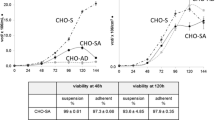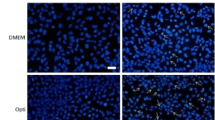Abstract
The overexpression of the antiapoptotic gene Bcl-2 has been previously shown to protect cells from undergoing apoptosis during exposure to environmental stress. There is strong evidence that, in addition to its well-known effects on apoptosis, Bcl-2 is involved in antioxidant protection and regulation of cell cycle progression. To determine if the overexpression of Bcl-2 could improve the process of adaptation to suspension and protein-free growth environments, we have studied the growth and viability of anchorage-dependent Chinese hamster ovary cell lines that differ only in there expression of Bcl-2. In addition, we examined the effect of combining Bcl-2 and p21CIP1 expression during adaptation to suspension and protein-free environments. The results of this study provide evidence of a clear reduction in the overall time required for the process of adaptation to both suspension and protein-free environments in Bcl-2 expressing cultures and that through the combined expression of p21CIP1 and Bcl-2, it is possible to further reduce the time. The Bcl-2 results support the well-demonstrated concept that this protein plays an important role in apoptotic signaling pathways and suggest that it may also provide more diverse functions beside its death-inhibiting role.









Similar content being viewed by others
References
Al-Rubeai M, Emery AN (1990) Mechanisms and kinetics of monoclonal antibody synthesis and secretion in synchronous and asynchronous hybridoma cell cultures. J Biotechnol 16:67–86
Al-Rubeai M, Emery AN, Chalder S, Jan DC (1992a) Specific antibody productivity and the cell cycle comparisons of batch, continuous and perfusion cultures. Cytotechnology 9:85–87
Al-Rubeai M, Emery AN, Chalder S (1992b) The effect of Pluronic F-68 on hybridoma cells in continuous culture. Appl Microbiol Biotechnol 37:44–45
Al-Rubeai M, Singh RP, Emery AN, Zhang Z (1995) Cell cycle and cell size dependence of susceptibility to hydrodynamic forces. Biotechnol Bioeng 46:88–92
Amos B, Al-Rubeai M, Emery AN (1994) Hybridoma growth and monoclonal antibody production in a dialysis prefusion system. Enzyme Microb Technol 16:688–695
Astley K, Naciri M, Racher A, Al-Rubeai M (2007) The role of p21CIP1 in adaptation of CHO cells to suspension and protein-free culture. Biotechnol 130:282–290
Bi J-X, Shuttleworth J, Al-Rubeai M (2004) Uncoupling of cell growth and proliferation results in enhancement of productivity in p21 arrested CHO cells. Biotechnol Bioeng 85:741–749
Comer M, Kearns M, Wahl J, Munster M, Lorenz T, Szperalski B, Behrendt U, Brunner H (1990) Industrial production of monoclonal antibodies and theraputic protiens by dialysis fermentation. Cytotechnol 3:295–299
Erhardt JA, Pittman RN (1998) Ectopic p21(WAF1) expression induces differentiation-specific cell cycle changes in PC12 cells characteristic of nerve growth factor treatment. J Biol Chem 273:23517–23523
Emery AN, Jan DCH, Al-Rubeai M (1995) Oxygenation of intensive cell culture system. Appl Microbiol Biotechnol 43:1028–1033
Fassnacht D, Rossing S, Strange J, Porter R (1998a) Long term cultivation of immortalised mouse hepatocytes in high cell density, fixed-bed reactor. Biotechnol Techniq 12:25–30
Fassnacht D, Rossing S, Franek F, Al-Rubeai M, Porter R (1998b) Effect of Bcl-2 expression on hybridoma cell growth in serum supplemented, protein free and diluted media. Cytotechnol 26:219–225
Franek F, Dolnikova J (1991) Nucleosomes occurring in protein free hybridoma cell cultures. Evidence for programmed cell death. FEBS Lett 248:285–287
Himmelfarb P, Thayer PS, Martin HE (1969) Spin filter culture: the propagation of mammalian cells in suspension. Science 164:555–557
Huppi K, Siwarski D, Dosik J, Michieli P, Chedid M, Reed S, Mock B, Givol D, Mushinski JF (1994) Molecular cloning, sequencing, chromosomal localization and expression of mouse p21 (Waf1). Oncogene 9:3017–3020
Ishaque A, Al-Rubeai M (1999) Role of Ca, Mg and K ions in determining apoptosis and extent of suppression afforded by bcl-2 during hybridoma cell culture. Apoptosis 4:335–355
Ishaque A, Al-Rubeai M (2002) Role of vitamins in determining apoptosis and extent of suppression by bcl-2 during hybridoma cell culture. Apoptosis 7:231–239
Itoh Y, Ueda H, Suzuki E (1995) Overexpression of Bcl-2, apoptosis suppressing gene: prolonged viable culture period of hybridoma and enhanced antibody production. Biotechnol Bioeng 48:118–122
Jan DCH, Emery AN, Al-rubeai M (1993) Introducing spin filter eliminates hydrodynamic damage to hybridomas in bioreactor. Biotechnol Techniq 7:351–356
Keane JT (2003) Effect of shear stress on expression of a recombinant protein by Chinese hamster ovary cells. Biotechnol Bioeng 81:211–220
Keen MJ, Steward TW (1995) Adaptation of cholesterol-requiring NS0 mouse myeloma cells to high density growth in a fully defined protein-free and cholesterol-free culture medium. Cyotechnol 17:203–211
Kilburn DG, Webb FC (1968) The cultivation of animal cells at controlled dissolved oxygen partial pressure. Biotechnol Bioeng 10:801–814
Kovar J, Franek F (1984) Serum-free medium for hybridoma and parental myeloma cell cultivation: a novel composition of growth-supporting substances. Immunol Lett 7:339–345
Ludwig A (1992) Influence of shear stress on adherent mammalian cells during division. Biotechnol Lett 14:881–884
Mastrangelo AJ, Hardwick JM, Betenbaugh MJ (1996) Bcl-2 inhibits apoptosis and extends recombinant protein production in cells infected with sinbis viral vectors. Cytotechnology 22:169–178
Mercille S, Massie B (1994) Induction of apoptosis in nutrient deprived cultures of hybridoma and myeloma cells. Biotechnol Bioeng 44:1140–1154
Mitchell-Logean C, Murhammer DW (1997) Bcl-2 expression in Spodoptera frugiperda Sf9 and Trichoplusia ni BT-Tn-5B1–4 insect cell: effect on recombinant protein expression and cell viability. Biotechnol Bioeng 56:380–388
Ong CP, Portner R, Markl H, Yamazaki Y, Yasuda K, Matsumura M (1994) High density cultivation of hybridoma in charged porous carriers. Biotechnol 34:259–268
Ozturk S, Kaseko G, Mahaworasilpa T, Coster HGL (2003) Adaptation of cell lines to serum-free culture medium. Hybridoma and Hybridomics 22:267–272
Perani A, Singh RP, Chauhan R, Al-Rubeai M (1999) Variable functions of bcl-2 in mediating bioreactor stress- induced apoptosis in hybridoma cells. Cytotechnology 28:177–188
Portner R, Rossing S, Koop M, Ludemann I (1997) Kinetic studies on hybridoma cells immobilised in fixed-bed reactors. Biotechnol Bioeng 55:535–541
Radford K, Niloperbowo W, Reid S, Greenfield PF (1991) Weaning of three hybridoma cell lines to serum free low protein medium. Cytotechnology 6:65–78
Simpson NH, Milner AN, Al-Rubeai M (1997) Prevention of hybridoma cell death by Bcl-2 during sub optimal culture conditions. Biotechnol Bioeng 54:1–16
Simpson NH, Singh RP, Emery AN, Al-Rubeai M (1999) Bcl-2 over-expression reduces growth rate and prolongs G1 phase in continuous chemostat cultures of hybridoma cells. Biotechnol Bioeng 64:174–186
Sinacore M, Drapeau D, Adamson SR (2000) Adaptation of mammalian cells to growth in serum free media. Mol Biotechnol 15:249–257
Singh RP, Al-Rubeai M, Gregory CD, Emery AN (1994) Cell death in bioreactors: a role for apoptosis. Biotechnol Bioeng 44:720–726
Tey BT, Al-Rubeai M (2004) Suppression of apoptosis in perfusion culture of myeloma NS0 enhances cell growth but reduces antibody productivity. Apoptosis 9:843–852
Tey BT, Singh L, Piredda M, Al-Rubeai M (2000a) Influence of Bcl-2 on cell death during the cultivation of a Chinese hamster ovary cell line expressing a chimeric antibody. Biotechnol Bioeng 68:31–43
Tey BT, Singh RP, Piredda L, Piacentini M, Al-Rubeai M (2000b) Influence of Bcl-2 on cell death during cultivation of a Chinese Hamster Ovary cell line expressing a chimeric antibody. Biotechnol Bioeng 68:31–43
Tharakan JP, Chau PC (1986) A radial flow hollow fiber reactor for large scale culture of mammalian cells. Biotechnol Bioeng 28:329–342
Watanabe S, Shuttleworth J, Al-Rubeai M (2002) Regulation of cell cycle and productivity in NS0 cells by the over-expression of p21. Biotechnol Bioeng 77:1–7
Westlund A, Haggstrom L (1998) Ammonium ion transport by the Na+ K+ 2C1- co transporter induces apoptosis in hybridoma cells. Biotechnol Lett 20:87–90
Acknowledgments
The parental cell line CHO 22H11 was supplied by Lonza Biologics. This work is partially funded by Science Foundation Ireland (SFI).
Author information
Authors and Affiliations
Corresponding author
Rights and permissions
About this article
Cite this article
Astley, K., Al-Rubeai, M. The role of Bcl-2 and its combined effect with p21CIP1 in adaptation of CHO cells to suspension and protein-free culture. Appl Microbiol Biotechnol 78, 391–399 (2008). https://doi.org/10.1007/s00253-007-1320-2
Received:
Revised:
Accepted:
Published:
Issue Date:
DOI: https://doi.org/10.1007/s00253-007-1320-2




